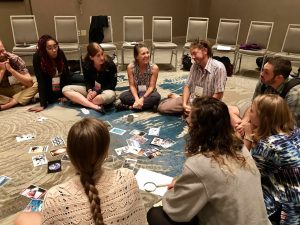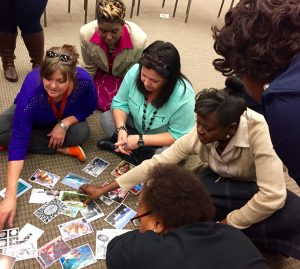Dec 03, 2018 Creating Meaning With Metaphor
Excerpt from Tips & Tools for the Art of Experiential Group Facilitation.
Since the beginning of civilization, humans have expressed themselves through symbols. Symbols, images, and objects help people communicate their thoughts and create meaning from experiences. They spark emotions and help people understand and communicate abstract concepts that cannot always be translated into words. Of all of the methods in my group facilitation and teaching toolbox, I find that my collections of metaphoric images and objects are the most powerful tools for igniting meaningful reflection both for individuals and groups. Reflection sparked by the use of image cards, pictures, artwork, and tangible objects have a richness, depth, substance and level of participation that verbal-only techniques rarely bring about.

Interesting objects and images capture participants’ attention, arouse emotion, and draw them into an experience or reflective discussion. People will often engage more readily and share more deeply when they have a visual or tactile symbol to represent their thoughts and feelings. Brain research suggests this might be because using metaphors and symbols in conversation stimulates multiple areas of the brain involved in other senses (Lacey et al., 2012) making this another effective activity to promote multiple neuronal connections and pathways to learning. I find that when I use metaphoric objects and image activities there is increased involvement from more introverted or reluctant group members. It seems that when participants can talk about the tangible object or image rather than about themselves or feelings directly, they are more comfortable and willing to share with the group.

As we have explored throughout the Art of Experiential Group Facilitation book and this blog, images and objects can become meaningful and engaging tools for facilitating reflection, goal setting, creating group norms, resolving conflict, and celebrating individual and group strengths and positive attributes. These methods are not only engaging and non-threatening; they allow abundant opportunities for creative, spontaneous, and meaningful interpretation of an experience. They promote participant control and ownership in learning experiences. A visual or tactile representation of an experience can be an effective reflective prompt long after the experience is over, reminding a group or participant of the key lessons learned.

There are a number of resources for putting together a collection of image cards, artwork, and objects. First, look through your junk drawer or recycle bin at home! I put together a fun collection of objects by filling an old toolbox with items found in basement, attic, and local second-hand stores.
The Miniature Metaphors™ came about from a request many years ago from an Outward Bound instructor looking for a pocket sized version of this activity. My original postcard collection started with a vintage family collection and old cards left over from vacations. Many facilitators I work with collect pictures from magazines as reflective prompts. My Pick-a-Postcard™ kits (see Experiential Tools store) are a mixture of my own photographs and images used with permission from museums. I find that participants respond differently to using cards or pictures than they do objects, and they will reach people in different ways.

Using Pictures and/or Objects in Reflection
• Ask participants to come to consensus on one image/object that best represents the group experience, strengths, or achievements.
• Invite the group pick three images/objects that represent three important skills used in an activity that can be useful in upcoming activities. Have them carry these objects with them and find a way to integrate them into the next activity or refer back to them to illustrate transfer of skills/learning to future situations.
• Invite group members to line up four or five images/objects to relate the story of their experience, demonstrating how they progressed through the activity, the day, or the course as a whole.
•Three cards to describe the group’s journey: working teams could choose three cards to tell a story of where they were as a team a year ago, where they are now, and where they hope to be this time next year.
• Invite participants to pick an image/object and then draw or write about it in their journals.
• Mix up methods to reach the varied learners in your groups and cultivate multiple pathways to learning. Groups respond differently to using images than they do to using objects, even though they are similar approaches.
• Challenge group members to choose an image/object for another person in the group as a memento or gift representing the strengths or contributions that person lent to the experience.
• Allow participants to keep the image/object that represents their strength or achievement as a memento/reminder.
• Use your creativity; the possibilities are endless.
References:
Lacey, S., Stilla, R., & Sathian, K. (2012). Metaphorically feeling: Comprehending textural metaphors activates Somatosensory Cortex. Brain Language, 120(3), and 416-421. Retrieved August 8, 2013, from http://www.ncbi.nlm.nih.gov/pmc/articles/PMC3318916/.
Inspired Educator, Inspired Learner: Experiential, Brain-Based Activities and Strategies to Engage, Motivate, Build Community, and Create Lasting Lessons by Jennifer Stanchfield 2014 Wood N Barnes Publishing.
Tips & Tools for the Art of Experiential Group Facilitation, Second Edition by Jennifer Stanchfield 2016 Wood N Barnes Publishing.



No Comments